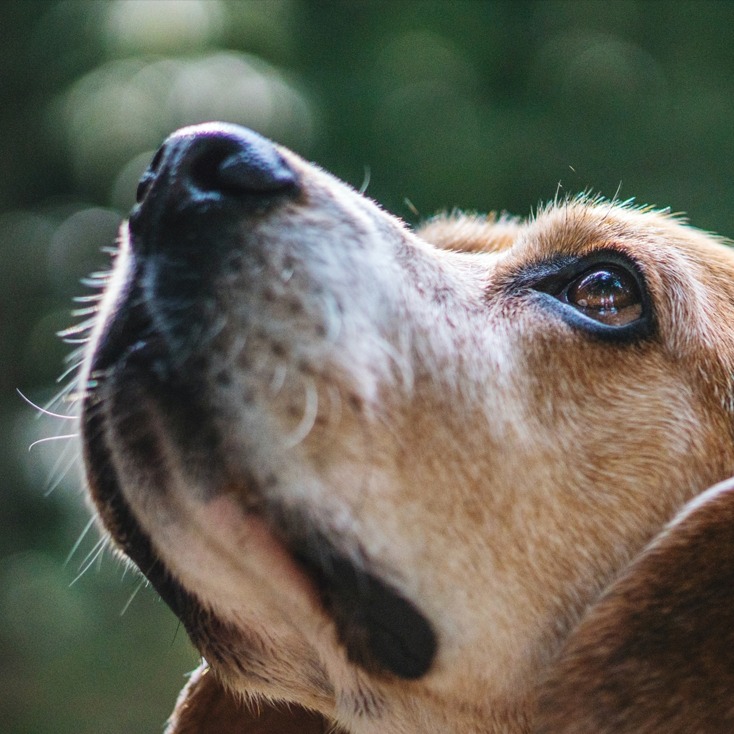Why Does Your Dog Sniff Everything?
You and your dog are out for your morning walk. He’s already done his business and you’re three blocks away from home. But every few steps, it’s like his nose is pulled by a powerful magnet to all the bushes, tree trunks and fire hydrants in sight. It’s cold, you might be late for work, and you find yourself yanking on the leash to get your pupper to please move it along!
So, is your dog just trying to squeeze in a few more moments of precious outdoor time? Or is there something deeper going on in that brain of theirs? In this article, we’ll talk about why sniffing is so important to dogs, and how you can end the endless leash tug-of-war.
Why do dogs sniff?
You know that your dog has a powerful nose (about 100,000x stronger than human’s!) but did you know that it’s also their primary sense? Dogs smell better than they can see, hear, taste, and feel. And their noses are evolutionarily designed to be able to separate out individual scent molecules for identification and storage in their scent memory bank. In fact, a dog’s nose contains two main chambers: the right is the first to be filled with air and based on whether a scent molecule is interesting to aversive, it will be sent to the left nostril for further processing.
It’s exactly for this reason that scientists differentiate between smelling and sniffing. While smelling is a more passive activity, sniffing is associated with active scent collection and brain processing. Sniffing is what has allowed dogs to track down prey, find mates, escape predators, keep peace between packs, and detect illness in their loved ones for thousands of years. And today, it allows dogs to scan their environment, not only in the present moment, but in the past as well, offering them a multi-layered view of their surroundings.
Some dogs are true scent tracking machines
All dogs have the ability and need to sniff. But some breeds have been carefully selected to out-sniff the rest. These include hound dogs such as Beagles, Bloodhounds, Basset Hounds, and Dachshunds, whose long ears help to pick up and hold onto scent molecules.
Age can affect your dog’s sense of smell, but not in the way that you think
Puppies love to explore every smelly stimuli, from a tiny blade of grass to piles of trash! And that’s partly because their sensory organs are in peak condition, bombarding them with new information all the time.
Here’s the scientific reason why: young dogs have a higher concentration of olfactory cells and a healthier olfactory epithelium (the nasal tissue that passes information from the nasal cavity to the brain.) But, that’s not the only reason that your puppy is overstimulated by smells. Because while older dogs may have lost some of their olfactory capacity, they have a much larger smell library to pull from. Thanks to their previous experience, they’re able to more efficiently sift through interesting smells from non-relevant smells.
You’ll notice as your dog ages that instead of being pulled to and fro by every smell, they may stop at specific sites where they know other animals have walked or the spot where they found that scrap of food months ago. In other words, dogs go from indiscriminate sniffing machines to full-on scent trackers as they age.
How can you accommodate your dog’s need to sniff?
Now that we’ve talked about why it’s so crucial for dogs to sniff, how can you incorporate sniffing into their routine in a way that is enjoyable for the both of you? Here are a few tips:
- Make your walks shorter in distance so that you can spend more time sniffing. By organizing your walks by time spent outside instead of distance, you won’t need to hurry your furry friend along as often.
- Teach a release cue when they’re stuck at a single point for too long. Instead of dragging them away, try luring with a tasty treat and offering a release cue, such as “that’ll do” or “let’s go!” Once you build up a positive association, your pup will be more willing to abandon that tantalizing smell when you call.
- Be extra patient on your dog’s super sniff days. Some days, your dog will be more tempted to sniff than others. And this may have to do with the weather—water molecules from rain and humidity trap scent molecules—or a new dog in the neighborhood. Instead of punishing them, give them extra time or extra motivation to keep it moving.
- If sniffing is preventing your dog from getting enough exercise, get creative. Some dogs need more exercise than a sniff-focused walk. So, you may need to get creative with your technique. Try playing a game of fetch in an area with fewer smells or using a fetch toy that is more interesting than the world around them.
- Drive with the windows down. One very simple way to satisfy your dog’s sniffing needs is to drive with the windows down. This will give your dog a smack in the face with millions of olfactory molecules! Make sure you keep them safely inside the car while they enjoy their scent buffet by installing BreezeGuard Screens!
- Provide them with smelly toys and chews at home. Your home isn’t usually a place where your dog will flex their sniffing muscles, but you can introduce some stimulating scent work without leaving the house! This can be done with at-home scavenger hunts and smelly toys and chews.
Your doggo appreciates your patience!
We understand that it can sometimes be frustrating to walk a super-sniffy dog. But, now that you know a bit more about the neurobiology of sniffing, we hope that you can appreciate this amazing feature of your dog’s evolution. So, take a few extra moments for your pup to explore the outside world. They’ll thank you for it!

